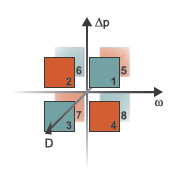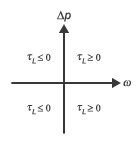Variable-Displacement Pump (TL)
Variable-displacement bidirectional thermal liquid pump
Libraries:
Simscape /
Fluids /
Thermal Liquid /
Pumps & Motors
Description
The Variable-Displacement Pump block represents a device that extracts power from a mechanical rotational network and delivers it to a thermal liquid network. The pump displacement varies during simulation according to the physical input signal at port D.
Ports A and B represent the pump inlets. Ports R and C represent the drive shaft and case. During normal operation, the pressure gain from port A to port B is positive if the angular velocity at port R relative to port C is positive.
Operating Modes
The block has four modes of operation, as shown by this image.

The working mode depends on the pressure gain from port A to port B, Δp = pB – pA; the angular velocity, ω = ωR – ωC; and the fluid volumetric displacement at port D. The figure above maps these modes to the octants of a Δp-ω-D chart:
The quadrant labeled 1 represents the forward pump mode. In this mode, the positive shaft angular velocity causes a pressure increase from port A to port B and flow from port A to port B
The quadrant labeled 2 represents the reverse motor mode. In this mode, the flow from port B to port A causes a pressure decrease from B to A and negative shaft angular velocity.
The quadrant labeled 3 represents the reverse pump mode. In this mode, the negative shaft angular velocity causes a pressure increase from port B to port A and flow from port B to port A
The quadrant labeled 4 represents the forward motor mode. In this mode, the flow from port A to port B causes a pressure decrease from A to B and positive shaft angular velocity.
The quadrant labeled 5 represents the reverse motor mode. In this mode, the flow from port B to port A causes a pressure decrease from B to A and positive shaft angular velocity.
The quadrant labeled 6 represents the forward pump mode. In this mode, the negative shaft angular velocity causes a pressure increase from port A to port B and flow from port A to port B
The quadrant labeled 7 represents the forward motor mode. In this mode, the flow from port A to port B causes a pressure decrease from A to B and negative shaft angular velocity.
The quadrant labeled 8 represents the reverse pump mode. In this mode, the positive shaft angular velocity causes a pressure increase from port B to port A and flow from port B to port A
The response time of the pump is negligible in comparison with the system response time. The pump reaches steady state nearly instantaneously and is treated as a quasi-steady component.
Energy Balance
The block associates the mechanical work done by the pump with an energy exchange. The governing energy balance equation is:
where:
ΦA and ΦB are the energy flow rates at ports A and B, respectively.
Phydro is the pump hydraulic power, which is a function of the pressure difference between the pump ports: .
The block generates mechanical power due to torque, τ, and angular velocity, ω:
Flow Rate and Driving Torque
The mass flow rate generated at the pump is
where:
is the actual mass flow rate.
is the ideal mass flow rate.
is the internal leakage mas flow rate.
The driving torque required to power the pump is
where:
τ is the actual driving torque.
τIdeal is the ideal driving torque.
τFriction is the friction torque.
The ideal mass flow rate is
and the ideal required torque is
where:
ρ is the average of the fluid densities at thermal liquid ports A and B.
ω is the shaft angular velocity.
Δp is the pressure gain from inlet to outlet.
D is the Displacement specified at physical signal port D.
Leakage and friction parameterization
You can parameterize leakage and friction analytically, by using tabulated efficiencies or losses, or by using input efficiencies or input losses.
When you set the Leakage and Friction Parameterization
parameter to Analytical, the leakage flow rate is
and the friction torque is
where:
KHP is the Hagen-Poiseuille coefficient for laminar pipe flows. The block computes this coefficient from the specified nominal parameters.
μ is the dynamic viscosity of the fluid, which is the average of the values at the ports.
k is the friction torque vs. pressure gain coefficient at nominal displacement, which the block determines from the Mechanical efficiency at nominal conditions parameter, ηm,nom:
τfr,nom is the friction torque at nominal conditions:
ΔpNom is the value of the Nominal pressure gain parameter. This value is the pressure gain at which the nominal volumetric efficiency is specified.
DNom is the value of the Nominal Displacement parameter.
τ0 is the value of the No-load torque parameter.
ωNom is the value of the Nominal shaft angular velocity parameter.
The block determines the Hagen-Poiseuille coefficient from the nominal fluid and component parameters
where:
ωNom is the value of the Nominal shaft angular velocity parameter. This value is the angular velocity at which the block specifies the nominal volumetric efficiency.
μNom is the value of the Nominal Dynamic viscosity parameter. This value is the dynamic viscosity at which the block specifies the nominal volumetric efficiency.
ηv,Nom is the value of the Volumetric efficiency at nominal conditions parameter. This is the volumetric efficiency that corresponds to the specified nominal conditions.
When you set the Leakage and friction parameterization
parameter to Tabulated data - volumetric and mechanical
efficiencies, the leakage flow rate is
and the friction torque is
where:
α is a numerical smoothing parameter for the motor-pump transition.
is the leakage flow rate in motor mode.
is the leakage flow rate in pump mode.
τFriction,Motor is the friction torque in motor mode.
τFriction,Pump is the friction torque in pump mode.
This hyperbolic function describes the smoothing parameter α
where:
ΔpThreshold is the value of the Pressure gain threshold for pump-motor transition block parameter.
ωThreshold is the value of the Angular velocity threshold for pump-motor transition block parameter.
DThreshold is the value of the Angular velocity threshold for motor-pump transition block parameter.
The block calculates the leakage flow rate from the volumetric efficiency, which the Volumetric efficiency table parameter specifies over the Δp–ɷ–D domain. When operating in pump mode, the leakage flow rate is:
where ηv is the volumetric efficiency, which the block obtains either by interpolation or extrapolation of the tabulated data. Similarly, when operating in motor mode, the leakage flow rate is:
The block calculates the friction torque from the mechanical efficiency, which the Mechanical efficiency table parameter specifies over the Δp–ɷ–D domain. When operating in pump mode, the friction torque is
where ηm is the mechanical efficiency, which the block obtains either by interpolation or extrapolation of the tabulated data. Similarly, when operating in motor mode, the friction torque is
When you set the Leakage and friction parameterization
parameter to Tabulated data - volumetric and mechanical
losses, the block specifies the leakage volumetric flow rate
in tabulated form over the
Δp–ɷ–D
domain:
The block calculates the mass flow rate due to leakage from the volumetric flow rate:
The block calculates the friction torque in tabulated form:
where qLeak(Δp,ω,D) and τFriction(Δp,ω,D) are the volumetric and mechanical losses, specified through interpolation or extrapolation of the tabulated data in the Volumetric loss table and Mechanical loss table parameters.
When you set the Leakage and friction parameterization
parameter to Input signal - volumetric and mechanical
efficiencies, the leakage flow rate and friction torque
calculations are identical to the Tabulated data - volumetric and
mechanical efficiencies setting. The block replaces the
volumetric and mechanical efficiency lookup tables with the physical signal
input ports EV and EM.
The efficiencies are positive quantities with values between
0 and 1.The block sets input values
outside of these bounds are to 0 for inputs smaller than
0 or 1 for inputs greater than
1. The block saturates the efficiency signals at the
value of the Minimum volumetric efficiency or
Minimum mechanical efficiency parameter and the
Maximum volumetric efficiency or Maximum
mechanical efficiency parameter.
When you set the Leakage and friction parameterization
parameter to Input signal - volumetric and mechanical
losses, the leakage flow rate and friction torque calculations
are identical to the Tabulated data - volumetric and mechanical
efficiencies setting. The block replaces the volumetric and
mechanical loss lookup tables with the physical signal input ports
LV and LM.
The block expects the inputs to be positive and sets the signs automatically from the Δp–ɷ quadrant where the component is operating. If you provide a negative signal, the block returns zero losses.
Assumptions and Limitations
The block treats the pump as a quasi-steady component.
The block ignores the effects of fluid inertia and elevation.
The pump wall is rigid.
The block ignores external leakage.

